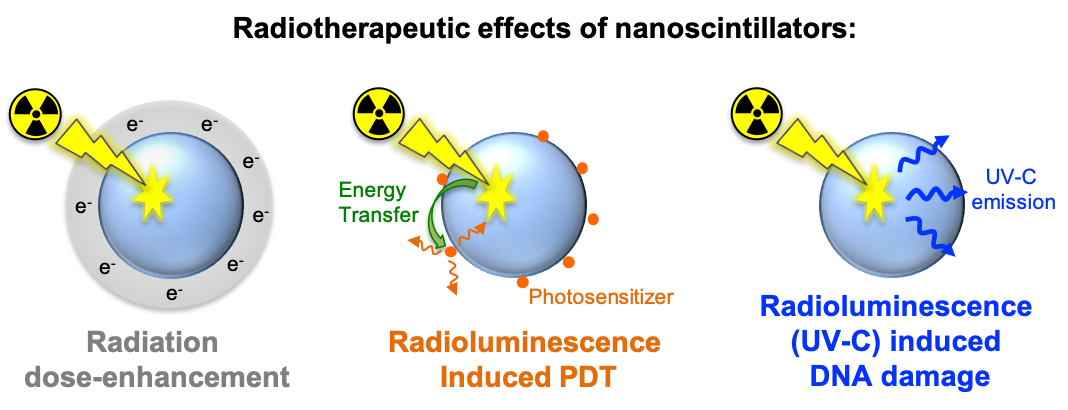- Share
- Share on Facebook
- Share on X
- Share on LinkedIn
When accumulated in the tumor prior to radiation therapy, nanoscintillators can act as internal light sources able to induce various therapeutic effects:
Radiation dose enhancement effect
As nanoscintillators are generally made of heavy atom elements, they are likely to induce a dose-enhancement effect when accumulated in the tumor prior to a low energy radiation therapy (orthovoltage range).
X-ray induced Photodynamic Therapy (X-PDT)
Photodynamic therapy (PDT) has seen long standing interest as a potential therapy for resistant cancers, but the main Achilles’ heel for its successful clinical exploitation is the use of poorly penetrating visible light. This limitation could be overcome by leveraging the radioluminescence properties of scintillating nanoparticles, which can be excited during radiation therapy by deep-penetrating X-rays. When infused in tumors, X-ray activated-nanoscintillators act as internal light sources and excite nearby photosensitizers.
UV-induced therapeutic effect
As nanoscintillators can emit UV radiations upon X-ray irradiation, they are likely to induce local DNA-damage during radiation therapy. Combining these DNA-damage to the effect of the radiation therapy may be a powerful way of potentiating radiotherapy.

This project is funded by the Region Rhône-Alpes Auvergne (Project NEPTUNE) and the “Ligue Contre le Cancer” foundation. We also received funding from the Jetons Cancer program from the Rotary Club.
References
- A.-L. Bulin, C. Truillet, R. Chouikrat, F. Lux, C. Frochot, D. Amans, G. Ledoux, O. Tillement, P. Perriat, M. Barberi-Heyob, C. Dujardin, J. Phys. Chem. C 2013, 117, 21583.
- A.-L. Bulin, A. Vasil’ev, A. Belsky, D. Amans, G. Ledoux, C. Dujardin, Nanoscale 2015, 7, 5744.
- S. Mallidi, S. Anbil, A.-L. Bulin, G. Obaid, M. Ichikawa, T. Hasan, Theranostics 2016, 6, 2458.
- A.-L. Bulin, M. Broekgaarden, D. Simeone, T. Hasan, Oncotarget 2019, 10, 2625.
- A.-L. Bulin, M. Broekgaarden, F. Chaput, V. Baisamy, J. Garrevoet, B. Busser, D. Brueckner, A. Youssef, J.-L. Ravanat, C. Dujardin, V. Motto-Ros, F. Lerouge, S. Bohic, L. Sancey, H. Elleaume, Advance Science 2020, Accepted pending revision.
Organisation of the project
Project Leader :
Dr Anne-Laure Bulin
anne-laure.bulin inserm.fr (anne-laure[dot]bulin[at]inserm[dot]fr)
inserm.fr (anne-laure[dot]bulin[at]inserm[dot]fr)
People involved in this project:
Dr Hélène Elleaume,
Dr Mans Broekgaarden,
Antonia Youssef,
Thibault Jacquet
Collaborators
Dr F. Chaput, Chemistry Department of the ENS Lyon
Dr Lucie Sancey, Institute for Advanced Biosciences, Grenoble
Dr Vaclav Cuba, Czech Technical University
Dr Jean-Luc Ravanat, CEA Grenoble
RMD, Boston, MA - USA
- Share
- Share on Facebook
- Share on X
- Share on LinkedIn